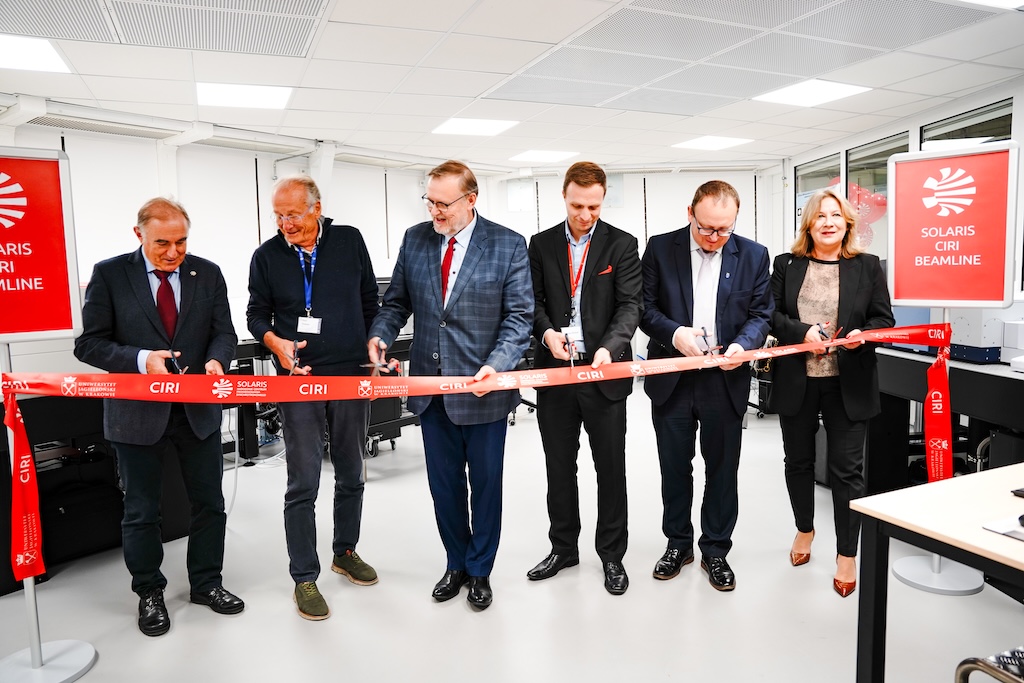CIRI opens at SOLARIS – new research opportunities on the infrared beamline
The SOLARIS Centre hosted the inauguration of the new CIRI (Chemical Infrared Imaging) beamline. It is the only synchrotron beamline in Poland operating in the infrared range, opening up entirely new research opportunities for scientists, from biomedicine to cultural heritage.
The research infrastructure of CIRI beamline shall be available to CERIC-ERIC users soon!

Group photo of the guests during the opening ceremony of the CIRI beamline. Photo by Dagmara Chylewska-Olech.
On October 3, 2025, the official opening ceremony of the new CIRI (Chemical Infrared Imaging) beamline was held at the Polish CERIC partner facility – the National Synchrotron Radiation Centre SOLARIS in Kraków. This long-awaited moment in the development of the synchrotron’s infrastructure significantly expands research capabilities with experiments in the infrared range.
The ceremony gathered numerous guests from Poland and abroad, above all distinguished representatives of the scientific community. Among those present were Prof. Wojciech Macyk, Vice-Rector for Research at the Jagiellonian University, Prof. Paul Dumas, member of the SOLARIS Scientific Advisory Committee, Prof. Wojciech Kwiatek from the Institute of Nuclear Physics, Prof. Kamilla Małek from the Faculty of Chemistry of the Jagiellonian University, Prof. Katarzyna Marzec and Prof. Maciej Sitarz from the AGH University of Krakow, Dr. Paulina Kozioł-Bohatkiewicz, Dr. Danuta Liberda-Matyja, as well as researchers and users of the SOLARIS synchrotron.

The event began with an address by Prof. Wojciech Macyk, Vice-Rector for Research at the Jagiellonian University, who emphasized the importance of investing in modern research infrastructure that enables the development of the entire scientific community. “The Jagiellonian University continuously supports the expansion of synchrotron instrumentation, understanding the mission of the Centre as providing shared research infrastructure to the scientific community”, said the Vice-Rector.
The next speaker was Prof. Marek Stankiewicz, Advisor to the Director of SOLARIS for Cooperation, who highlighted the need to build the potential of Polish science and strengthen its position in Europe, perfectly exemplified by today’s opening of one of only three infrared beamlines in Europe. “All the beamlines at our Centre are built in response to the needs of the scientific community. Each is also the result of international collaboration. The CIRI beamline inaugurated today is one of the very few in Europe, and by far the most modern among those operating in the infrared”, emphasized Prof. Stankiewicz.
Prof. Paul Dumas from the SOLEIL synchrotron, a member of the Scientific Advisory Committee, also spoke at the ceremony. “This beamline is the result of collaboration between the Polish and French scientific communities. Congratulations to its creators and to the entire SOLARIS team”, he said.
Following the official addresses, the new CIRI beamline was presented by Dr. hab. Tomasz Wróbel, Prof. UJ, who highlighted both its unique measurement capabilities and its broad research prospects. “The construction of the CIRI beamline is a process that began back in the 1990s. Today’s opening is the culmination of many years of work involving a great number of people. I would like to thank the beamline team, the entire SOLARIS staff, and our partners from the international scientific community for their support and collaboration, without which this project would not have been possible”, said Dr. Wróbel.
The highlight of the event was the ceremonial ribbon-cutting, which symbolically opened the CIRI beamline for future experiments. Guests had the opportunity to see the new infrastructure and visit the three endstations, each offering imaging capabilities at different spatial resolutions. By harnessing one of the brightest synchrotron sources in the infrared range, the beamline provides world-class research opportunities.
The applications of CIRI cover a wide spectrum of fields – from biomedical sciences, through solid-state physics and catalysis, to the study and preservation of cultural heritage. With this investment, the SOLARIS Centre and the Jagiellonian University are further strengthening their position on the map of European research infrastructures, creating new opportunities for collaboration for scientists from Poland and abroad.



